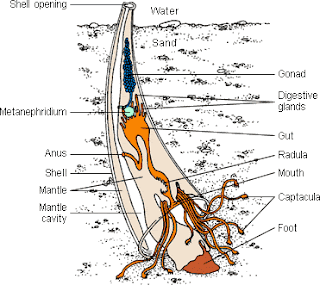 |
| Scaphopoda or Tusk Shell Photo from: http://www.molluscs.at/scaphopoda |
Along the coasts of the America's the tusk shell was used by natives to make decorative adornments and was often used as currency which every school child knows as "wampum."
The tusk shell is considered to be related to clams and oysters but unlike it's bi-valve relatives the tusk only has one shell comprised of a calcified material that surrounds the animal within and generally wider at the head (which is buried in the seabed) than at the top which extends above the sediment or sand it is buried in. This shell appears in shape much like an elephant's tusk and therefore it's name, but the similarities end there as it is open at both ends and only grows to about 1.5" in length.
The animal within the shell uses a foot to dig into the surrounding sand then enlarges it to move.
The primary diet of Scaphopoda's are Foraminifiers, one celled organisms which it captures with thread-like tentacles called captaculas which extend out from the shell and sift through the sand around the foot.
Adult Scaphopoda's have both male and female sex organs. It releases it's eggs one at a time and then fertilizes them externally. The young will then go through a free-swimming larval stage (known as a trochophore stage) before entering a larval stage (known as a veliger stage), after which it finally becomes an adult.
 |
| Anatomy of a Tusk Shell from: http://www.ucmp.berkeley.edu |
The Scaphopoda breaths by siphoning water into it's shell opening at the top and circulating it through the mantle cavity by tiny hair-like appendages called cilia with the mantle absorbing the oxygen. When the water is depleted of oxygen it is ejected through the top opening by the animal squeezing the mantle with it's body to close the mantle then allowing new oxygenated water back in when it relaxes and the process repeats.
In like manner the animals waste is expelled from the anus into the mantle cavity and ejected with the oxygen depleted water.
Though Scaphopoda do have a heart it is so small as to be almost non-essential since the blood flows freely and is circulated by the movement of the foot as it swells and deflates in it's process of inhaling the oxygenated water and expelling it.

